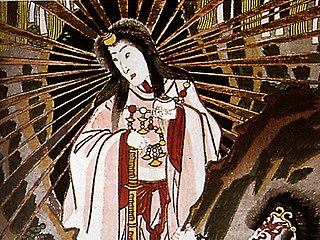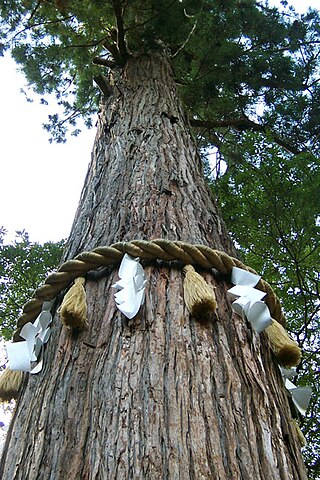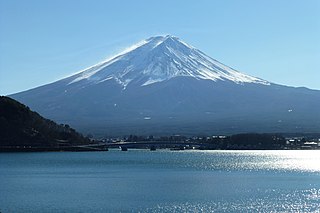Kami are the deities, divinities, spirits, mythological, spiritual, or natural phenomena that are venerated in the Shinto religion. They can be elements of the landscape, forces of nature, beings and the qualities that these beings express, and/or the spirits of venerated dead people. Many kami are considered the ancient ancestors of entire clans. Traditionally, great leaders like the Emperor could be or became kami.

Shinto is a religion originating from Japan. Classified as an East Asian religion by scholars of religion, its practitioners often regard it as Japan's indigenous religion and as a nature religion. Scholars sometimes call its practitioners Shintoists, although adherents rarely use that term themselves. There is no central authority in control of Shinto, with much diversity of belief and practice evident among practitioners.

Japanese mythology is a collection of traditional stories, folktales, and beliefs that emerged in the islands of the Japanese archipelago. Shinto traditions are the cornerstones of Japanese mythology. The history of thousands of years of contact with Chinese and various Indian myths are also key influences in Japanese religious belief.

Inari Ōkami, also called Ō-Inari (大稲荷), is the Japanese kami of foxes, fertility, rice, tea and sake, agriculture and industry, and general prosperity and worldly success, and is one of the principal kami of Shinto. In earlier Japan, Inari was also the patron of swordsmiths and merchants. Alternatingly-represented as male &/or female, Inari is sometimes seen as a collective of three or five individual kami. Inari appears to have been worshipped since the founding of a shrine at Inari Mountain in 711 AD, although some scholars believe that worship started in the late 5th century.

Kunado-no-Kami, alternately Kunato-no-Kami, Funado-no-Kami, Funato-no-Kami, or Chimata-no-Kami, are Japanese local gods connected chiefly with protection against disaster and malicious spirits.

A Shinto shrine is a structure whose main purpose is to house ("enshrine") one or more kami, the deities of the Shinto religion.

Yasaka Shrine, once called Gion Shrine, is a Shinto shrine in the Gion District of Kyoto, Japan. Situated at the east end of Shijō-dōri, the shrine includes several buildings, including gates, a main hall and a stage. The Yasaka shrine is dedicated to Susanoo in the tradition of the Gion faith as its chief kami, with his consort Kushinadahime on the east, and eight offspring deities on the west. The yahashira no mikogami include Yashimajinumi no kami, Itakeru no kami, Ōyatsuhime no kami, Tsumatsuhime no kami, Ōtoshi no kami, Ukanomitama no kami, Ōyatsuhiko no kami, and Suseribime no mikoto.

Shinbutsu-shūgō, also called Shinbutsu shūShinbutsu-konkō, is the syncretism of Shinto and Buddhism that was Japan's main organized religion up until the Meiji period. Beginning in 1868, the new Meiji government approved a series of laws that separated Japanese native kami worship, on one side, from Buddhism which had assimilated it, on the other.

Dōsojin is a generic name for a type of Shinto kami popularly worshipped in Kantō and neighboring areas in Japan where, as tutelary deities of borders and paths, they are believed to protect travellers, pilgrims, villages, and individuals in "transitional stages" from epidemics and evil spirits. Also called Sae no kami or Sai no kami (障の神・塞の神), Dōrokujin (道陸神) or Shakujin. Dōsojin are often represented as a human couple, carved male or female genitals, large stones or statues, or even tall poles along a road.
Toshigami, also known as Ōtoshi-no-kami, is a Japanese kami and a part of the Shinto pantheon.

Kanjō (勧請) in Shinto terminology indicates a propagation process through which a kami, previously divided through a process called bunrei, is invited to another location and there re-enshrined.

A yorishiro (依り代/依代/憑り代/憑代) in Shinto terminology is an object capable of attracting spirits called kami, thus giving them a physical space to occupy during religious ceremonies. Yorishiro are used during ceremonies to call the kami for worship. The word itself literally means "approach substitute". Once a yorishiro actually houses a kami, it is called a shintai. Ropes called shimenawa decorated with paper streamers called shide often surround yorishiro to make their sacredness manifest. Persons can play the same role as a yorishiro, and in that case are called yorimashi or kamigakari.
This is the glossary of Shinto, including major terms on the subject. Words followed by an asterisk (*) are illustrated by an image in one of the photo galleries.

Hokora or hokura is a miniature Shinto shrine either found on the precincts of a larger shrine and dedicated to folk kami, or on a street side, enshrining kami not under the jurisdiction of any large shrine. Dōsojin, minor kami protecting travelers from evil spirits, can for example be enshrined in a hokora.

In Shinto, shintai, or go-shintai when the honorific prefix go- is used, are physical objects worshipped at or near Shinto shrines as repositories in which spirits or kami reside. Shintai used in Shrine Shinto can be also called mitamashiro.
Ta-no-Kami (田の神) is a kami who is believed to observe the harvest of rice plants or to bring a good harvest, by Japanese farmers. Ta in Japanese means "rice fields". Ta-no-Kami is also called Noushin or kami of peasants. Ta-no-Kami shares the kami of corn, the kami of water and the kami of defense, especially the kami of agriculture associated with mountain faith and veneration of the dead. Ta-no-Kami in Kagoshima Prefecture and parts of Miyazaki Prefecture is unique; farmers pray before Ta-no-Kami stone statues in their communities.

In Japan, a chinjusha is a Shinto shrine which enshrines a tutelary kami; that is, a patron spirit that protects a given area, village, building or a Buddhist temple. The Imperial Palace has its own tutelary shrine dedicated to the 21 guardian gods of Ise Shrine. Tutelary shrines are usually very small, but there is a range in size, and the great Hiyoshi Taisha for example is Enryaku-ji's tutelary shrine. The tutelary shrine of a temple or the complex the two together form are sometimes called a temple-shrine. If a tutelary shrine is called chinju-dō, it is the tutelary shrine of a Buddhist temple. Even in that case, however, the shrine retains its distinctive architecture.

Until the Meiji period (1868–1912), the jingū-ji were places of worship composed of a Buddhist temple and a Shinto shrine, both dedicated to a local kami. These complexes were born when a temple was erected next to a shrine to help its kami with its karmic problems. At the time, kami were thought to be also subjected to karma, and therefore in need of a salvation only Buddhism could provide. Having first appeared during the Nara period (710–794), jingū-ji remained common for over a millennium until, with few exceptions, they were destroyed in compliance with the Kami and Buddhas Separation Act of 1868. Seiganto-ji is a Tendai temple part of the Kumano Sanzan Shinto shrine complex, and as such can be considered one of the few shrine-temples still extant.
Kami is an endangered, under-described Eastern Bantu language. It is reported to be spoken by 5,518 people in the Morogoro region of Tanzania as recorded by Mradi wa Lugha in 2009. The number of fluent speakers left is significantly lower. In field trips to the area, no children or adolescents spoke the language, which means that the language is threatened with extinction. The youngest informant was in his thirties, and he could only understand Kami, not speak it.













